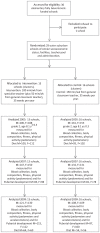Physical education and blood lipid concentrations in children: the LOOK randomized cluster trial
- PMID: 24204594
- PMCID: PMC3808412
- DOI: 10.1371/journal.pone.0076124
Physical education and blood lipid concentrations in children: the LOOK randomized cluster trial
Abstract
Background and objectives: Elevated blood lipids during childhood are predictive of dyslipidemia in adults. Although obese and inactive children have elevated values, any potentially protective role of elementary school physical education is unknown. Our objective was to determine the effect of a modern elementary school physical education (PE) program on the blood lipid concentrations in community-based children.
Methods: In this cluster-randomized controlled trial, 708 healthy children (8.1±0.3 years, 367 boys) in 29 schools were allocated to either a 4-year intervention program of specialist-taught PE (13 schools) or to a control group of the currently practiced PE conducted by generalist classroom teachers. Fasting blood lipids were measured at ages 8, 10, and 12 years and intervention and control class activities were recorded.
Results: Intervention classes included more fitness work and more moderate and vigorous physical activity than control classes (both p<0.001). With no group differences at baseline, the percentage of 12 year-old boys and girls with elevated low density lipoprotein cholesterol (LDL-C, >3.36mmol.L(-1),130 mg/dL) was lower in the intervention than control group (14% vs. 23%, p = 0.02). There was also an intervention effect on mean LDL-C across all boys (reduction of 9.6% for intervention v 2.8% control, p = 0.02), but not girls (p = 0.2). The intervention effect on total cholesterol mirrored LDL-C, but there were no detectable 4-year intervention effects on high-density lipoprotein cholesterol or triglycerides.
Conclusions: The PE program delivered by specialist teachers over four years in elementary school reduced the incidence of elevated LDL-C in boys and girls, and provides a means by which early preventative practices can be offered to all children.
Trial registration: Australia New Zealand Clinical Trial Registry ANZRN12612000027819 https://www.anzctr.org.au/Trial/Registration/TrialReview.aspx?id=347799.
Conflict of interest statement
Figures



References
-
- Juhola J, Magnussen CG, Viikari JS, Kahonen M, Hutri-Kahonen N, et al. (2011) Tracking of serum lipid levels, blood pressure, and body mass index from childhood to adulthood: the Cardiovascular Risk in Young Finns Study. J Pediatr 159: 584–590. - PubMed
-
- Srinivasan SR, Frontini MG, Xu J, Berenson GS (2006) Utility of childhood non-high-density lipoprotein cholesterol levels in predicting adult dyslipidemia and other cardiovascular risks: the Bogalusa Heart Study. Pediatrics 118: 201–206. - PubMed
-
- Frontini MG, Srinivasan SR, Xu J, Tang R, Bond MG, et al. (2008) Usefulness of childhood non-high density lipoprotein cholesterol levels versus other lipoprotein measures in predicting adult subclinical atherosclerosis: the Bogalusa Heart Study. Pediatrics 121: 924–929. - PubMed
-
- Juonala M, Magnussen CG, Venn A, Dwyer T, Burns TL, et al. (2010) Influence of age on associations between childhood risk factors and carotid intima-media thickness in adulthood: the Cardiovascular Risk in Young Finns Study, the Childhood Determinants of Adult Health Study, the Bogalusa Heart Study, and the Muscatine Study for the International Childhood Cardiovascular Cohort (i3C) Consortium. Circulation 122: 2514–2520. - PubMed
-
- Daniels SR, Greer FR (2008) Lipid screening and cardiovascular health in childhood. Pediatrics 122: 198–208. - PubMed
Publication types
MeSH terms
Substances
LinkOut - more resources
Full Text Sources
Other Literature Sources

